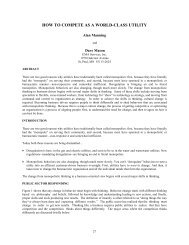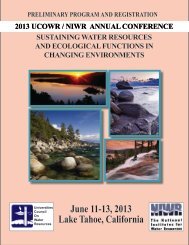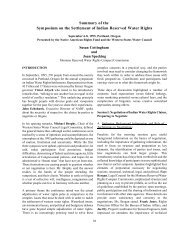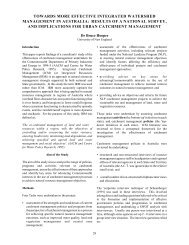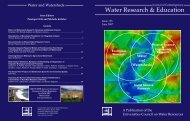80UNIVERSITIES COUNCIL ON WATER RESOURCESJOURNAL OF CONTEMPORARY WATER RESEARCH & EDUCATIONISSUE 135, PAGES 80-85, DECEMBER 2006<strong>Water</strong> Governance at the European UnionAna BarreiraInstituto Internacional de Derecho y Medio Ambiente, SpainIt has been recognized that the current watercrisis is a crisis <strong>of</strong> water governance (Global<strong>Water</strong> Partnership 2000). Resolving watergovernance problems will lead to the achievement<strong>of</strong> sustainable water resources management <strong>and</strong>development. <strong>Water</strong> governance refers to the range<strong>of</strong> political, social, economic, <strong>and</strong> administrativesystems that are in place to regulate thedevelopment <strong>and</strong> management <strong>of</strong> water resources<strong>and</strong> provision <strong>of</strong> water services at different levels<strong>of</strong> society (Global <strong>Water</strong> Partnership 2002).Governance issues have important implicationsfor the management <strong>of</strong> water resources at alladministrative levels — global, regional, national<strong>and</strong> local — <strong>and</strong> good governance is a prerequisitefor the successful implementation <strong>of</strong> Integrated<strong>Water</strong> Resources Management (IWRM), accordingto the Global <strong>Water</strong> Partnership (GWP) (2002).<strong>Water</strong> laws provide the framework for watergovernance systems <strong>and</strong> are the pillar for achievingeffective governance in a given country. Themain principles for effective water governanceare: openness <strong>and</strong> transparency, inclusion <strong>and</strong>communication, coherence <strong>and</strong> integration, equity<strong>and</strong> ethics. At the European Union (EU) level,the <strong>Water</strong> Framework Directive 1 (WFD) providesthe basic elements to contribute to effective watergovernance in European Union member states 2 .The main objective <strong>of</strong> this article is to present thewater governance system <strong>of</strong> the European Union,based primarily on the European Community<strong>Water</strong> Framework Directive. Firstly, it reviews theEuropean Union context, in particular EuropeanCommunity (EC) environmental law <strong>and</strong> policy.It follows with a brief analysis <strong>of</strong> the instrumentsshaping the European Community water lawarchitecture. In particular, it will emphasize the<strong>Water</strong> Framework Directive that, since its entry int<strong>of</strong>orce on December 22, 2000, represents the primarywater policy legislation in the European Union.Finally, some conclusions will be provided.The EU Context: European CommunityEnvironmental Law <strong>and</strong> PolicyThe European Community is a uniqueinternational organization. The European Court<strong>of</strong> Justice (ECJ) already held in 1964 that “it hasits own institutions 3 , its own personality, its ownlegal capacity <strong>and</strong> capacity <strong>of</strong> representation onthe international plane <strong>and</strong>, more particularly, realpowers stemming from a limitation <strong>of</strong> sovereigntyor a transfer <strong>of</strong> powers from the States to theCommunity. The member states have limited theirsovereign rights, albeit within limited fields, <strong>and</strong>have thus created a body <strong>of</strong> law which binds boththeir nationals <strong>and</strong> themselves.” 4 The EuropeanCommunity is the first pillar <strong>of</strong> what is known asthe European Union which also is also comprised<strong>of</strong> two additional pillars: the Common Foreign <strong>and</strong>Security Policy <strong>and</strong> Cooperation in Justice <strong>and</strong>Home Affairs.Environmental policy, including water policy,is European Community policy whose implementationis shared between the European Union<strong>and</strong> member states. This shared implementationimplies that the European Community establishesminimum st<strong>and</strong>ards for environmental protectionwhen it is necessary to intervene at the Europeanlevel 5 while leaving member states the freedom toestablish stricter protection measures 6 . Communitypolicy on the environment, including programsfor future legislation <strong>and</strong> action, has beenprogressively developed in six action programson the environment. Member states are obliged toUCOWRJOURNAL OF CONTEMPORARY WATER RESEARCH & EDUCATION
<strong>Water</strong> Governance at the European Union81transpose <strong>and</strong> implement the minimum st<strong>and</strong>ardsapproved at the European level mainly in theform <strong>of</strong> directives 7 . Therefore, directives on watermust be incorporated into the domestic law <strong>of</strong> itsmember states <strong>of</strong>fering an indication <strong>of</strong> futuredevelopments in national water laws.The white paper on European Union governance 8recommended the use <strong>of</strong> appropriate legislativeinstruments to facilitate compliance with EuropeanCommunity law. It also recommended that morefrequent use be made <strong>of</strong> the “framework directives,”as they are less complicated texts, <strong>of</strong>fer greaterflexibility with respect to their implementation, <strong>and</strong>tend to be agreed to more quickly by the council<strong>and</strong> the European parliament.European Community <strong>Water</strong> Law <strong>and</strong>PolicyAs a result <strong>of</strong> the First Environmental ActionProgram <strong>of</strong> 1973, water legislation was one <strong>of</strong>the first sectors to be covered by the EuropeanCommunity environmental policy (Lanz <strong>and</strong>Scheuer 2001). European Community legislationto protect water quality originated in 1973 withthe adoption <strong>of</strong> a directive prohibiting the sale<strong>and</strong> use <strong>of</strong> certain detergents with a low level <strong>of</strong>biodegradability (S<strong>and</strong>s 2004). Today more than 25water-related directives <strong>and</strong> decisions are found.The first legislative approach (1975-1980)used two kinds <strong>of</strong> techniques. Thus, we finddirectives <strong>and</strong> decisions providing environmentalquality st<strong>and</strong>ards (EQS) for specific types <strong>of</strong>water (surface water, fish water, shellfish water,bathing water <strong>and</strong> drinking water directives)<strong>and</strong> establishing emission limit values (ELV)for specific water uses (dangerous substancesdirective <strong>and</strong> the ground water directive). Thesecond approach to water legislation (1980-1991)used new techniques (Nitrates <strong>and</strong> Urban Waste<strong>Water</strong> Directives) <strong>and</strong> completed the dangeroussubstances directive through daughter directiveson specific substances.In spite <strong>of</strong> this developed legal framework,nine member states were found guilty by theEuropean Court <strong>of</strong> Justice for not complyingwith water legislation in 42 cases concerning17 directives (Demmke <strong>and</strong> Unfried 2001). Theexistence <strong>of</strong> diverse regulatory instruments aswell as growing environmental problems derivedfrom the intensification <strong>of</strong> economic water usesrequired more coherent action from the EuropeanCommunity in the field <strong>of</strong> water. After five years<strong>of</strong> negotiation in the European Community,the <strong>Water</strong> Framework Directive was approvedat the end <strong>of</strong> 2000 <strong>and</strong> Members States had totranspose it into their national laws before 22December 2003. Just a few months before thatdate, the European Environment Agency (EEA)reported some progress achieved in the ecologicalquality <strong>of</strong> rivers, reducing pollution by oxygenconsumingsubstances <strong>and</strong> phosphorus as well aswater abstractions, except for southern Europe(European Environment Agency 2003). However,it also warned on areas where no progress had takenplace: nitrate pollution mainly from agriculture,over withdrawal for irrigation, energy use <strong>and</strong>tourism in southern Europe, <strong>and</strong> the presence <strong>of</strong>pesticides in ground water <strong>and</strong> drinking water(European Environment Agency 2003).The <strong>Water</strong> Framework Directive: AnInstrument for Good <strong>Water</strong> Governance inthe EUThis Directive introduces key elements toachieve effective water governance at the EuropeanUnion level, a coherent <strong>and</strong> effective legal <strong>and</strong>institutional framework, water-pricing policies,public participation <strong>and</strong> an integrated waterresources management system (Barreira 2003). Itprovides an umbrella for the implementation <strong>of</strong>the various instruments <strong>of</strong> European Union waterpolicy as well as introducing new st<strong>and</strong>ards <strong>and</strong>tools for the protection <strong>of</strong> the ecological quality<strong>of</strong> waters. As a result, until the <strong>Water</strong> FrameworkDirective becomes fully operational, the currentEuropean Community <strong>Water</strong> legislation is inforce 9 .The <strong>Water</strong> Framework Directive introduced aremarkable change in community water legislation.This policy moved from protection <strong>of</strong> particularwaters <strong>of</strong> special interest such as nature areas,specific aquatic organisms or drinking water, toprotection <strong>and</strong> use based on overall appreciation<strong>of</strong> the hydrology <strong>and</strong> ecology <strong>of</strong> the entire naturalcycle <strong>of</strong> each river basin (Olsen 2001).Its purpose is to establish a framework for theprotection <strong>of</strong> all waters, which include inl<strong>and</strong>surface waters, transitional waters, coastal watersJOURNAL OF CONTEMPORARY WATER RESEARCH & EDUCATIONUCOWR
- Page 3:
Journal of ContemporaryWater Resear
- Page 6 and 7:
2Bruce Hooperinstitutional, and tem
- Page 11 and 12:
IWRM: Governance, Best Practice, an
- Page 13 and 14:
IWRM: Defi nitions and Conceptual M
- Page 15 and 16:
IWRM: Defi nitions and Conceptual M
- Page 17 and 18:
IWRM: Defi nitions and Conceptual M
- Page 19:
IWRM: Defi nitions and Conceptual M
- Page 22 and 23:
18Cardwell. Cole, Cartwright, and M
- Page 24 and 25:
20Mostert26 water boards responsibl
- Page 26 and 27:
22MostertTable 1. Third National Wa
- Page 28 and 29:
24MostertImplementationThe ambitiou
- Page 30 and 31:
26MostertBiswas, A. K. 2004b. Respo
- Page 32 and 33:
28UNIVERSITIES COUNCIL ON WATER RES
- Page 34 and 35: 30Ashton, Turton, and Rouxresource
- Page 36 and 37: 32Ashton, Turton, and Rouxassumptio
- Page 38 and 39: 34Ashton, Turton, and RouxEffective
- Page 40 and 41: 36UNIVERSITIES COUNCIL ON WATER RES
- Page 42 and 43: 38Hussey and Doversin water policy
- Page 44 and 45: 40Hussey and Dovers1994 Council of
- Page 46 and 47: 42Hussey and Doversestablished Thes
- Page 48 and 49: 44Hussey and DoversTable 1. Typolog
- Page 50 and 51: 46Hussey and Doversassessment appro
- Page 52 and 53: 48Hussey and Doverspolicy goals.Bey
- Page 54 and 55: 50Hussey and DoversFrawley, K. 1994
- Page 56 and 57: 52Mitchelloften took three to four
- Page 58 and 59: 54Mitchelltree preservation plans;
- Page 60 and 61: 56UNIVERSITIES COUNCIL ON WATER RES
- Page 62 and 63: 58Genskow and Borna series of chall
- Page 64 and 65: 60Genskow and BornTable 1. Watershe
- Page 66 and 67: 62Genskow and Bornthe first Dungene
- Page 68 and 69: 64Genskow and BornWashington, DC.Ko
- Page 70 and 71: 66Green and Fernández-BilbaoWithin
- Page 72 and 73: 68Green and Fernández-Bilbaosubjec
- Page 74 and 75: 70Green and Fernández-Bilbaoinflue
- Page 76 and 77: 72Green and Fernández-BilbaoBerbel
- Page 78 and 79: 74UNIVERSITIES COUNCIL ON WATER RES
- Page 80 and 81: 76BallweberEstablish AdvisoryCommit
- Page 82 and 83: 78Ballweberattributes in others (Ch
- Page 86 and 87: 82Barreiraand ground water. To this
- Page 88 and 89: 84Barreirawith other states for int
- Page 90 and 91: 86UNIVERSITIES COUNCIL ON WATER RES
- Page 92 and 93: 88Davis and ThrelfallResource Manag
- Page 94 and 95: 90Davis and ThrelfallTable 2. Thirt
- Page 96 and 97: 92Davis and Threlfallby regional an
- Page 98 and 99: 94Davis and Threlfallenforcement, a
- Page 100 and 101: 96Davis and Threlfallhusbandry prac
- Page 102 and 103: 98Davis and ThrelfallNew Zealand: T
- Page 104 and 105: 100UNIVERSITIES COUNCIL ON WATER RE
- Page 106 and 107: 102Lamoree and van SteenbergenIt is
- Page 108 and 109: 104Lamoree and van Steenbergenand n
- Page 110 and 111: 106Lamoree and van Steenbergeninter
- Page 112 and 113: 108BourgetWorks Planner Capability
- Page 114 and 115: 110Bourgetwith over 600 people resp
- Page 116 and 117: 112Bourgetgovernment’s intrusion
- Page 118 and 119: 114Bourget4.management, drought man
- Page 120 and 121: 116McKayFigure 1. The four paradigm
- Page 122 and 123: 118McKay4. Paradigm 4 (which commen
- Page 124 and 125: 120McKaythree main functions:1. ass
- Page 126 and 127: 122McKayState Implementation of the
- Page 128 and 129: 124McKayTable 2. Corporate governan
- Page 130 and 131: 126McKayFigure 4. Qu. 26 - The ESD
- Page 132 and 133: 128McKayFigure 7. Qu.93- This organ
- Page 134 and 135:
130McKayBrundtland Report. 1987. Ou
- Page 136 and 137:
132UCOWR BOARD OF DIRECTORS/COMMITT
- Page 138 and 139:
134BENEFITS OF UCOWR MEMBERSHIPThe
- Page 140 and 141:
136Past Issues of the Journal of Co
- Page 142 and 143:
138Academic Organizations Membershi
- Page 144 and 145:
140Individual Membership Applicatio
- Page 146 and 147:
Universities Council on Water Resou
- Page 148:
Integrated Water Resources Manageme



